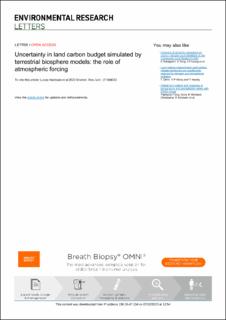| dc.description.abstract | Global estimates of the land carbon sink are often based on simulations by terrestrial biosphere models (TBMs). The use of a large number of models that differ in their underlying hypotheses, structure and parameters is one way to assess the uncertainty in the historical land carbon sink. Here we show that the atmospheric forcing datasets used to drive these TBMs represent a significant source of uncertainty that is currently not systematically accounted for in land carbon cycle evaluations. We present results from three TBMs each forced with three different historical atmospheric forcing reconstructions over the period 1850–2015. We perform an analysis of variance to quantify the relative uncertainty in carbon fluxes arising from the models themselves, atmospheric forcing, and model-forcing interactions. We find that atmospheric forcing in this set of simulations plays a dominant role on uncertainties in global gross primary productivity (GPP) (75% of variability) and autotrophic respiration (90%), and a significant but reduced role on net primary productivity and heterotrophic respiration (30%). Atmospheric forcing is the dominant driver (52%) of variability for the net ecosystem exchange flux, defined as the difference between GPP and respiration (both autotrophic and heterotrophic respiration). In contrast, for wildfire-driven carbon emissions model uncertainties dominate and, as a result, model uncertainties dominate for net ecosystem productivity. At regional scales, the contribution of atmospheric forcing to uncertainty shows a very heterogeneous pattern and is smaller on average than at the global scale. We find that this difference in the relative importance of forcing uncertainty between global and regional scales is related to large differences in regional model flux estimates, which partially offset each other when integrated globally, while the flux differences driven by forcing are mainly consistent across the world and therefore add up to a larger fractional contribution to global uncertainty. | |
